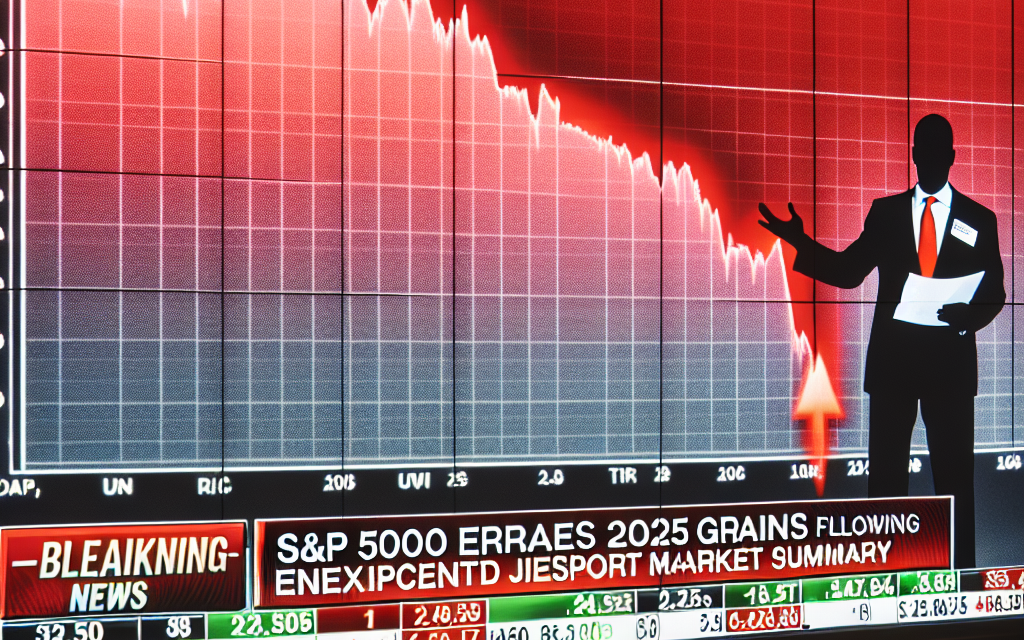“S&P 500 Dips as Unexpected Jobs Report Erases 2025 Gains: A Market Wake-Up Call.”
Introduction
The S&P 500 experienced a significant downturn, erasing its gains for 2025 in response to an unexpected jobs report that revealed stronger-than-anticipated employment figures. This development sent shockwaves through the financial markets, as investors recalibrated their expectations for interest rates and economic growth. The report highlighted a resilient labor market, prompting concerns about potential inflationary pressures and the Federal Reserve’s monetary policy trajectory. As a result, major indices faced volatility, reflecting the market’s reaction to shifting economic indicators and their implications for future corporate earnings and investment strategies.
S&P 500 Performance Analysis Post-Jobs Report
In the wake of an unexpected jobs report, the S&P 500 has experienced a significant shift, erasing gains that had been projected for 2025. This development has sent ripples through the financial markets, prompting analysts and investors alike to reassess their strategies and outlooks. The jobs report, which revealed a surge in employment figures that exceeded economists’ expectations, initially sparked optimism among market participants. However, as the implications of this data began to unfold, the S&P 500’s trajectory took a downward turn, reflecting a complex interplay of economic indicators and investor sentiment.
The unexpected increase in job creation, while seemingly positive, raised concerns about potential inflationary pressures and the Federal Reserve’s response to a tightening labor market. Investors, who had been buoyed by the prospect of a stable economic recovery, suddenly found themselves grappling with the possibility of interest rate hikes sooner than anticipated. This shift in sentiment was palpable in the trading sessions that followed the report, as market participants recalibrated their expectations for both corporate earnings and economic growth.
As the S&P 500 began to retrace its steps, it became evident that sectors traditionally viewed as safe havens, such as utilities and consumer staples, gained traction. Conversely, growth-oriented sectors, particularly technology and consumer discretionary, faced heightened volatility. This divergence in performance underscored the market’s reaction to the jobs report, as investors sought refuge in more stable investments amid rising uncertainty. The rotation away from growth stocks highlighted a broader trend of risk aversion, as market participants weighed the implications of a potentially overheating economy against the backdrop of ongoing geopolitical tensions and supply chain disruptions.
Moreover, the S&P 500’s decline was exacerbated by profit-taking behavior among investors who had previously capitalized on the index’s upward momentum. As the market reached new highs in the preceding months, many traders opted to lock in gains, further contributing to the downward pressure on stock prices. This phenomenon is not uncommon in the wake of significant economic announcements, as the initial euphoria often gives way to a more cautious approach as the realities of the economic landscape set in.
In addition to the immediate market reactions, analysts are now closely monitoring the broader economic indicators that could influence the S&P 500’s performance in the coming months. Key metrics such as consumer spending, inflation rates, and manufacturing output will play a crucial role in shaping investor sentiment and market dynamics. As the Federal Reserve continues to navigate its monetary policy in response to evolving economic conditions, the S&P 500 will likely remain sensitive to any signals regarding interest rate adjustments.
In conclusion, the S&P 500’s erasure of 2025 gains following the unexpected jobs report serves as a reminder of the intricate relationship between economic data and market performance. While the initial reaction to positive job growth was one of optimism, the subsequent reassessment of inflationary risks and interest rate expectations has led to a more cautious market environment. As investors adapt to these changing dynamics, the S&P 500’s future trajectory will depend on a multitude of factors, including ongoing economic indicators and the Federal Reserve’s policy decisions. The current landscape underscores the importance of vigilance and adaptability in navigating the complexities of the financial markets.
Impact of Unexpected Jobs Data on Market Trends
The recent unexpected jobs report has sent shockwaves through the financial markets, particularly impacting the S&P 500, which has now erased its gains for the year 2025. This development underscores the intricate relationship between employment data and market performance, highlighting how economic indicators can significantly influence investor sentiment and market trends. As the report revealed a surge in job creation that exceeded analysts’ expectations, it raised concerns about potential inflationary pressures and the Federal Reserve’s subsequent monetary policy decisions.
Initially, the robust job numbers were interpreted positively, suggesting a resilient economy capable of sustaining growth. However, as investors digested the implications of such data, a more cautious outlook emerged. The fear of rising inflation, fueled by increased consumer spending and wage growth, prompted speculation about the Federal Reserve’s potential interest rate hikes. Consequently, this shift in sentiment led to a sell-off in equities, with the S&P 500 experiencing a notable decline as investors sought to recalibrate their portfolios in response to the changing economic landscape.
Moreover, the unexpected nature of the jobs report added an element of uncertainty to the market. Investors typically rely on economic forecasts and trends to make informed decisions, but when actual data deviates significantly from expectations, it can lead to volatility. In this case, the sudden influx of jobs created a ripple effect, prompting traders to reassess their positions and strategies. As a result, sectors that had previously benefited from a bullish market sentiment, such as technology and consumer discretionary, faced significant pressure, contributing to the overall decline of the S&P 500.
In addition to the immediate market reactions, the unexpected jobs data also raises questions about the sustainability of the current economic recovery. While job growth is generally a positive sign, it can also signal an overheating economy, which may prompt the Federal Reserve to take preemptive measures to curb inflation. This potential tightening of monetary policy could lead to higher borrowing costs, which in turn may dampen consumer spending and business investment. As such, the interplay between job growth and interest rates becomes a critical focal point for investors navigating the complexities of the current market environment.
Furthermore, the implications of the jobs report extend beyond the immediate market fluctuations. Investors are now faced with the challenge of reassessing their long-term strategies in light of potential shifts in economic policy. The uncertainty surrounding future interest rate hikes may lead to increased volatility in the stock market, as investors weigh the risks and rewards of various asset classes. Consequently, many are turning to alternative investments or diversifying their portfolios to mitigate potential losses in a fluctuating market.
In conclusion, the unexpected jobs report has had a profound impact on market trends, particularly for the S&P 500, which has now erased its gains for 2025. The interplay between job growth, inflation concerns, and monetary policy has created a complex environment for investors. As they navigate these challenges, it is essential to remain vigilant and adaptable, recognizing that economic indicators can shift rapidly and influence market dynamics in unforeseen ways. Ultimately, the ability to respond to these changes will be crucial for investors seeking to protect their portfolios and capitalize on emerging opportunities in an ever-evolving economic landscape.
Key Factors Behind the S&P 500’s 2025 Gains
The S&P 500, a benchmark for the U.S. stock market, experienced significant gains in 2025, driven by a confluence of favorable economic indicators, corporate earnings growth, and investor sentiment. As the year unfolded, several key factors contributed to the index’s upward trajectory, reflecting a robust economic environment that encouraged investment and consumer spending.
One of the primary drivers of the S&P 500’s gains was the consistent improvement in economic data. Throughout 2025, the U.S. economy demonstrated resilience, with GDP growth rates exceeding expectations. This growth was bolstered by strong consumer spending, which accounted for a substantial portion of economic activity. As consumers felt more confident in their financial situations, they increased their expenditures on goods and services, thereby stimulating demand and encouraging businesses to expand. This positive feedback loop not only supported corporate revenues but also enhanced investor confidence, leading to increased capital inflows into the stock market.
In addition to robust economic growth, corporate earnings played a pivotal role in the S&P 500’s performance. Many companies within the index reported better-than-expected earnings, driven by a combination of operational efficiencies, cost management, and strategic investments. Sectors such as technology, healthcare, and consumer discretionary saw particularly strong performance, as companies capitalized on emerging trends and innovations. The positive earnings reports not only reassured investors about the health of the underlying businesses but also contributed to a favorable valuation environment, further propelling the index higher.
Moreover, the monetary policy landscape in 2025 was characterized by a supportive stance from the Federal Reserve. In response to the improving economic conditions, the Fed maintained a cautious approach to interest rate hikes, opting instead to prioritize economic stability and growth. This accommodative monetary policy environment fostered a low-interest-rate climate, which encouraged borrowing and investment. As a result, businesses were able to finance expansion projects more easily, while consumers benefited from lower borrowing costs, further fueling economic activity. The combination of low interest rates and strong corporate performance created a conducive environment for equity markets, allowing the S&P 500 to flourish.
Investor sentiment also played a crucial role in the index’s gains throughout the year. As the market continued to rise, a sense of optimism permeated the investment community. Retail and institutional investors alike were drawn to the potential for capital appreciation, leading to increased participation in the stock market. This influx of capital not only supported stock prices but also contributed to a sense of momentum that further encouraged investment. Additionally, the growing interest in sustainable and socially responsible investing led to a shift in capital flows toward companies that prioritized environmental, social, and governance (ESG) factors, further enhancing the performance of the S&P 500.
In conclusion, the S&P 500’s impressive gains in 2025 can be attributed to a combination of strong economic growth, robust corporate earnings, supportive monetary policy, and positive investor sentiment. These factors created a favorable environment for equity markets, allowing the index to reach new heights. However, as evidenced by the recent unexpected jobs report that erased some of these gains, the market remains sensitive to economic data and external shocks, underscoring the importance of vigilance and adaptability in investment strategies.
Investor Reactions to the Latest Jobs Report
In the wake of the latest jobs report, investor sentiment has shifted dramatically, reflecting a complex interplay of economic indicators and market expectations. The unexpected nature of the report, which revealed a significant deviation from anticipated job growth, has led to a reevaluation of investment strategies across various sectors. As the S&P 500 index erases its gains for 2025, the implications of this report resonate deeply within the financial community, prompting a wave of reactions from both institutional and retail investors.
Initially, the report indicated a surge in unemployment claims, which caught many analysts off guard. This unexpected rise in claims has raised concerns about the overall health of the labor market, leading to fears of a potential economic slowdown. Consequently, investors have begun to reassess their positions, particularly in sectors that are sensitive to consumer spending and economic growth. For instance, the retail and consumer discretionary sectors have experienced heightened volatility, as market participants grapple with the implications of reduced consumer confidence and spending power.
Moreover, the report has sparked discussions regarding the Federal Reserve’s monetary policy. With inflationary pressures still a concern, the central bank’s next moves are under intense scrutiny. Investors are now speculating whether the Fed will maintain its current interest rate trajectory or consider adjustments in response to the labor market’s performance. This uncertainty has led to fluctuations in bond yields, as traders react to the possibility of a more dovish stance from the Fed. As a result, the bond market has seen increased activity, with investors seeking refuge in safer assets amid the prevailing uncertainty.
In addition to these macroeconomic considerations, sector-specific reactions have also been notable. Technology stocks, which had previously enjoyed a robust rally, have faced headwinds as investors recalibrate their expectations for growth in a potentially slowing economy. The tech sector’s reliance on consumer spending and business investment makes it particularly vulnerable to shifts in economic sentiment. Consequently, many investors are adopting a more cautious approach, reallocating their portfolios to include defensive stocks that are less sensitive to economic fluctuations.
Furthermore, the energy sector has not been immune to the report’s fallout. With concerns about economic growth potentially dampening demand for energy, oil prices have experienced downward pressure. This has prompted investors to reassess their positions in energy stocks, leading to a sell-off in the sector. As a result, market participants are increasingly focused on the interplay between economic indicators and commodity prices, recognizing that shifts in one can significantly impact the other.
As the market digests the implications of the jobs report, it is clear that investor reactions are multifaceted and nuanced. The interplay between economic data, monetary policy, and sector performance creates a complex landscape for decision-making. In this environment, investors are urged to remain vigilant and adaptable, as the potential for further volatility looms. Ultimately, the unexpected jobs report serves as a reminder of the inherent uncertainties in the market, underscoring the importance of a well-informed and strategic approach to investing. As the S&P 500 continues to navigate these turbulent waters, the reactions of investors will undoubtedly shape the trajectory of the market in the months to come.
Economic Indicators and Their Influence on the S&P 500
The S&P 500, a benchmark for the U.S. stock market, is profoundly influenced by various economic indicators, which serve as critical barometers for investor sentiment and market performance. Among these indicators, employment data holds particular significance, as it reflects the overall health of the economy and can sway market dynamics in substantial ways. Recently, an unexpected jobs report sent ripples through the financial markets, leading to the erasure of gains that the S&P 500 had accumulated in 2025. This development underscores the intricate relationship between economic indicators and stock market performance.
To begin with, employment figures are often viewed as a leading indicator of economic activity. When job growth is robust, it typically signals a thriving economy, which can bolster consumer confidence and spending. Conversely, disappointing job numbers can raise concerns about economic stagnation or contraction, prompting investors to reassess their positions. In this context, the recent jobs report, which revealed a significant slowdown in hiring, caught many analysts off guard and triggered a wave of selling across major indices, including the S&P 500.
Moreover, the implications of employment data extend beyond immediate market reactions. Investors closely monitor jobless claims, wage growth, and labor force participation rates, as these metrics provide deeper insights into economic trends. For instance, rising wages can indicate a tightening labor market, which may lead to inflationary pressures. In such scenarios, the Federal Reserve might consider adjusting interest rates to maintain economic stability. Consequently, any indication of inflation can lead to volatility in the stock market, as investors recalibrate their expectations for future corporate earnings.
In addition to employment data, other economic indicators, such as GDP growth, consumer spending, and manufacturing output, also play pivotal roles in shaping market sentiment. A strong GDP report can bolster confidence in the economy, leading to increased investment in equities. Conversely, weak consumer spending figures can signal potential downturns, prompting investors to adopt a more cautious approach. The interconnectedness of these indicators means that a single report can have cascading effects on market performance, as seen in the recent reaction to the jobs report.
Furthermore, the influence of economic indicators on the S&P 500 is not merely a matter of immediate reactions; it also reflects broader trends in investor psychology. Market participants often engage in a delicate balancing act, weighing the implications of economic data against their expectations for future growth. When unexpected data emerges, it can disrupt this balance, leading to rapid shifts in market sentiment. The recent jobs report serves as a prime example of how quickly investor confidence can wane, resulting in a swift correction in stock prices.
In conclusion, the relationship between economic indicators and the S&P 500 is complex and multifaceted. Employment data, in particular, serves as a critical touchstone for assessing economic health and can significantly influence market dynamics. The recent unexpected jobs report that erased the S&P 500’s gains in 2025 highlights the importance of staying attuned to economic signals and their potential ramifications for the stock market. As investors navigate this ever-evolving landscape, understanding the interplay between economic indicators and market performance will remain essential for making informed investment decisions.
Future Market Predictions Following Job Data Release
The recent unexpected jobs report has sent ripples through the financial markets, particularly impacting the S&P 500, which has now erased its gains for 2025. This development raises critical questions about the future trajectory of the market and the broader economic landscape. Analysts and investors alike are now grappling with the implications of this data, which suggests a more complex economic environment than previously anticipated.
In light of the jobs report, which revealed a significant slowdown in job creation, market participants are reassessing their expectations for economic growth. The report indicated that the labor market, a key driver of consumer spending and overall economic health, is not as robust as many had hoped. Consequently, this has led to a reevaluation of corporate earnings forecasts, as companies may face challenges in maintaining growth in a less favorable economic climate. As a result, analysts are predicting a potential slowdown in earnings growth for the upcoming quarters, which could further weigh on stock prices.
Moreover, the unexpected nature of the jobs report has heightened concerns about inflation and interest rates. The Federal Reserve has been closely monitoring employment data as part of its strategy to manage inflation. With the labor market showing signs of weakness, there is speculation about whether the Fed will adjust its monetary policy stance. If the central bank decides to pause or even reverse its interest rate hikes, it could provide some relief to the markets. However, such a move would also signal that the economy is not performing as well as previously thought, which could dampen investor sentiment.
Transitioning from these macroeconomic considerations, it is essential to examine how different sectors of the market may respond to the evolving landscape. For instance, sectors that are typically sensitive to economic cycles, such as consumer discretionary and industrials, may experience heightened volatility as investors reassess their risk exposure. Conversely, defensive sectors like utilities and consumer staples may attract more interest as investors seek stability in uncertain times. This shift in sector performance could lead to a rotation in investment strategies, with a focus on preserving capital rather than chasing growth.
Furthermore, the global economic context cannot be overlooked. Geopolitical tensions, supply chain disruptions, and varying recovery rates across different regions are all factors that could influence market dynamics. Investors are increasingly aware that the interconnectedness of global markets means that developments in one area can have far-reaching implications. As such, market predictions will likely incorporate a broader range of variables, including international trade policies and foreign economic indicators.
In conclusion, the unexpected jobs report has prompted a significant reassessment of market expectations for the S&P 500 and the broader economy. As investors navigate this uncertain terrain, they will need to remain vigilant and adaptable. The interplay between economic data, corporate earnings, and monetary policy will be crucial in shaping market sentiment in the coming months. While the immediate outlook may appear challenging, it is essential to recognize that markets are inherently dynamic, and opportunities may arise even in times of uncertainty. As such, a careful analysis of both macroeconomic trends and sector-specific developments will be vital for making informed investment decisions moving forward.
Historical Context: S&P 500 Responses to Jobs Reports
The S&P 500, a benchmark for the U.S. stock market, has a long history of responding to economic indicators, with jobs reports being among the most significant. These reports, which provide insights into employment trends and overall economic health, often serve as catalysts for market movements. Historically, the S&P 500 has demonstrated a pattern of volatility in the wake of jobs data releases, reflecting investor sentiment and expectations regarding economic growth.
For instance, when job growth exceeds forecasts, the S&P 500 typically experiences upward momentum, as investors interpret strong employment figures as a sign of a robust economy. Conversely, disappointing job numbers can lead to declines, as they may signal economic weakness or potential slowdowns. This relationship between employment data and market performance is not merely coincidental; it is rooted in the broader implications of job growth on consumer spending, corporate profits, and monetary policy.
In the context of the recent unexpected jobs report that led to the S&P 500 erasing its gains for 2025, it is essential to consider the historical precedents. The market’s reaction to jobs data can often be immediate and pronounced. For example, during periods of economic recovery, such as the post-2008 financial crisis, strong job reports frequently bolstered investor confidence, leading to significant rallies in the S&P 500. In contrast, during times of economic uncertainty, such as the onset of the COVID-19 pandemic, negative job reports triggered sharp declines, as investors sought to reassess their positions in light of deteriorating economic conditions.
Moreover, the Federal Reserve’s monetary policy decisions are closely tied to employment data, further influencing market dynamics. When job growth is strong, the Fed may consider tightening monetary policy to prevent overheating in the economy. This potential for interest rate hikes can create apprehension among investors, leading to market sell-offs. Conversely, weak job reports may prompt the Fed to adopt a more accommodative stance, which can provide a temporary boost to the S&P 500 as investors anticipate lower borrowing costs and increased liquidity.
The recent jobs report that caused the S&P 500 to erase its gains for 2025 serves as a reminder of the delicate balance between economic indicators and market performance. Investors often react not only to the data itself but also to the broader implications of that data on future economic conditions and policy decisions. In this instance, the unexpected nature of the jobs report likely caught many off guard, leading to a swift reassessment of market positions.
As we reflect on the historical context of the S&P 500’s responses to jobs reports, it becomes clear that these economic indicators play a crucial role in shaping market sentiment. The interplay between employment data, investor expectations, and monetary policy creates a complex landscape that can lead to significant market fluctuations. Understanding this relationship is essential for investors seeking to navigate the often unpredictable nature of the stock market. Ultimately, the recent developments underscore the importance of remaining vigilant and informed, as economic indicators continue to influence market trajectories in profound ways.
Q&A
1. **What caused the S&P 500 to erase its 2025 gains?**
An unexpected jobs report indicated stronger-than-anticipated employment growth, leading to concerns about potential interest rate hikes.
2. **What was the impact of the jobs report on investor sentiment?**
The report heightened fears of inflation and tighter monetary policy, causing investors to sell off stocks.
3. **How did the S&P 500 perform following the jobs report?**
The S&P 500 experienced a significant decline, wiping out its gains for the year 2025.
4. **What sectors were most affected by the market downturn?**
Technology and consumer discretionary sectors were particularly hard hit due to their sensitivity to interest rate changes.
5. **What was the market’s reaction in terms of trading volume?**
Trading volume surged as investors reacted quickly to the news, indicating heightened volatility.
6. **How did analysts interpret the jobs report’s implications for the Federal Reserve?**
Analysts suggested that the strong job numbers could prompt the Federal Reserve to consider raising interest rates sooner than expected.
7. **What are the potential long-term effects of this jobs report on the stock market?**
If the labor market remains strong, it could lead to sustained volatility in the stock market as investors adjust their expectations for monetary policy.
Conclusion
The S&P 500’s erasure of its 2025 gains following an unexpected jobs report highlights the market’s sensitivity to economic data and the potential for volatility in response to labor market conditions. This reaction underscores the importance of employment figures in shaping investor sentiment and market trends, indicating that economic indicators can significantly influence stock performance and investor confidence.





